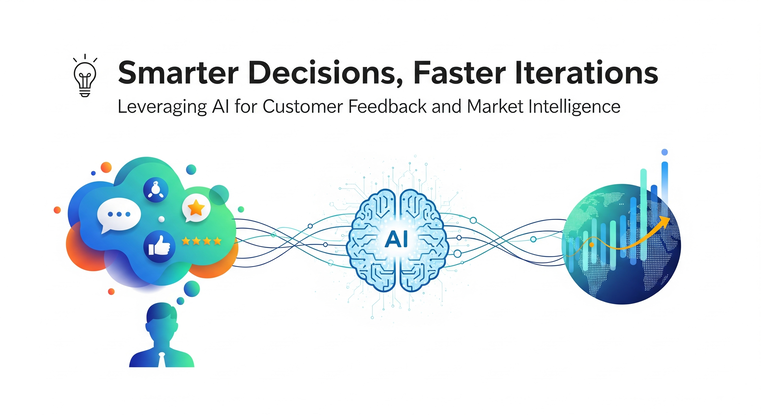
Smarter Decisions, Faster Iterations: Leveraging AI for Customer Feedback and Market Intelligence.
Introduction: The Business Imperative of Speed and Intelligence
In the age of digital transformation, businesses are no longer competing on price or product features alone—they’re competing on speed, adaptability, and customer-centric innovation. Markets evolve faster than ever, customer expectations shift overnight, and competitors leverage new technologies at breakneck pace.
Traditional methods of collecting customer feedback—such as surveys, focus groups, and manual research—are slow and limited. Similarly, market intelligence gathered through periodic reports and analyst insights often arrives too late to influence decisions in real time.
This is where Artificial Intelligence (AI) becomes a transformative force. By combining advanced data analytics, machine learning (ML), and natural language processing (NLP), AI enables businesses to:
-
Analyze customer feedback instantly.
-
Extract hidden patterns and sentiments.
-
Forecast market shifts and competitor moves.
-
Iterate products and strategies faster.
In essence, AI bridges the gap between raw data and smart, timely decision-making—turning feedback into foresight and iterations into innovations.
Why Traditional Approaches Fall Short
Before we explore AI’s role, let’s consider the limitations of conventional feedback and market intelligence systems:
-
Time Lag – Manual surveys and reports can take weeks or months, while customer preferences change daily.
-
Data Silos – Feedback scattered across emails, CRM, call centers, and social media makes it difficult to form a holistic picture.
-
Human Bias – Manual interpretation of customer responses often introduces subjectivity.
-
Scalability Issues – A business may receive thousands of reviews daily, far beyond the capacity of a research team to analyze.
-
Reactive Decision-Making – Insights often arrive after problems escalate or opportunities pass.
AI addresses all of these bottlenecks by providing real-time, unbiased, and scalable intelligence.
How AI is Transforming Customer Feedback Analysis 1. Sentiment Analysis at Scale
AI-powered Natural Language Processing (NLP) algorithms can analyze millions of data points across reviews, chat logs, and social posts to detect emotions such as satisfaction, frustration, or excitement. Unlike simple keyword tracking, modern models can recognize context, sarcasm, and cultural nuances.
➡ Example: Starbucks uses AI to scan global feedback, identifying flavor trends and localizing menus based on real-time consumer preferences.
2. Multichannel Data Integration
Customers express opinions across diverse platforms—emails, live chats, call transcripts, Twitter threads, and product forums. AI-driven platforms unify this data into a centralized “Voice of Customer” (VoC) hub, giving decision-makers a 360° view.
➡ Example: Airlines integrate call center transcripts and Twitter complaints to proactively address service delays.
3. Predictive Customer Insights
Instead of waiting for issues to arise, AI predicts emerging dissatisfaction signals. For instance, if multiple customers subtly complain about “sluggish app loading,” AI models can flag performance issues before they escalate into mass churn.
➡ Example: Netflix uses predictive algorithms to anticipate viewer dissatisfaction and adjust recommendations accordingly.
4. Automated Response and Resolution
AI doesn’t just analyze—it can act. With AI-driven chatbots and recommendation engines, companies respond instantly to feedback, suggesting fixes, discounts, or resolutions in real time.
➡ Example: E-commerce giants like Amazon leverage AI chatbots to handle complaints, reducing response times and improving loyalty.
AI in Market Intelligence: From Data to Strategy
While feedback deals with existing customers, market intelligence expands the view to the entire competitive landscape. AI empowers businesses to analyze:
1. Competitor Activity TrackingAI continuously scans competitor websites, press releases, product launches, and pricing updates to provide real-time alerts.
➡ Example: Retailers like Walmart use AI to track competitor promotions and adjust pricing dynamically.
2. Trend Forecasting
By analyzing search patterns, news articles, and social chatter, AI identifies emerging trends before they peak.
➡ Example: Fashion brands use AI to spot rising micro-trends on TikTok, adjusting production instantly.
3. Demand Forecasting
Machine learning models process historical sales, weather patterns, economic indicators, and consumer sentiment to forecast future demand with remarkable accuracy.
➡ Example: Unilever uses AI for global demand forecasting, reducing supply chain disruptions.
4. Risk Detection and Scenario Planning
AI systems simulate “what-if” scenarios—predicting how market shifts, economic slowdowns, or competitor disruptions could impact the business.
➡ Example: Investment firms leverage AI to anticipate risks in volatile markets, adjusting portfolios instantly.
Key Benefits of Leveraging AI for Feedback & Market Research
-
Speed – Real-time insights reduce decision-making lag from weeks to minutes.
-
Accuracy – AI minimizes human bias and error.
-
Scalability – Capable of analyzing millions of data points simultaneously.
-
Cost Efficiency – Cuts down on traditional research expenses.
-
Agility – Enables rapid product iterations and quicker go-to-market strategies.
-
Personalization – Drives hyper-targeted customer engagement.
AI Tools and Solutions Businesses Are Using in 2025
-
Qualtrics XM + AI – Advanced customer experience analytics.
-
MonkeyLearn – NLP-based text and sentiment analysis.
-
Sprout Social AI Insights – Social media intelligence.
-
ChatGPT Enterprise – Conversational analysis and reporting.
-
Tableau + Einstein AI (Salesforce) – Predictive data visualization.
-
Crimson Hexagon AI – Market research and trend analysis.
Real-World Case Studies Case 1: Spotify
Spotify leverages AI to analyze user feedback and listening behavior, enabling real-time playlist personalization and faster music recommendations. This results in higher engagement and reduced churn.
Case 2: Coca-ColaCoca-Cola uses AI to track social sentiment around new product launches. During a recent campaign, AI flagged negative perceptions early, allowing the brand to pivot its messaging and salvage reputation.
Case 3: AmazonAmazon’s AI models analyze millions of product reviews daily to improve seller quality, recommend products, and streamline customer service. This enables constant iterations on their marketplace ecosystem.
Best Practices for Businesses
-
Set Clear Objectives – Define if the goal is improving satisfaction, identifying risks, or spotting trends.
-
Adopt a Hybrid Model – AI for scale, human experts for context.
-
Prioritize Data Quality – Poor input leads to flawed outputs.
-
Ethical AI Use – Be transparent with customers about how their data is analyzed.
-
Continuous Learning – Retrain models with fresh datasets to avoid outdated insights.
The Future of AI in Customer Intelligence (2025 & Beyond)
The next wave of AI-driven insights will focus on:
-
Generative AI for Strategy: AI not only analyzing but also drafting strategic recommendations.
-
Real-Time Personalization: Tailoring experiences dynamically, second by second.
-
Emotion AI: Detecting tone, stress, and micro-expressions from video and voice calls.
-
Autonomous Decision-Making: AI systems directly executing business adjustments—such as changing ad campaigns or tweaking product prices—without human intervention.
-
Integration with Web3 & IoT: Feedback gathered from connected devices and decentralized platforms for deeper intelligence.
Businesses that adopt AI for smarter decisions and faster iterations will not just survive disruption—they will lead industries with agility and foresight.
Conclusion
In a world where speed, accuracy, and customer focus define market leadership, AI is the catalyst for transformation. By leveraging AI for customer feedback and market intelligence, businesses can detect opportunities faster, iterate products quicker, and build stronger customer relationships.
The future belongs to organizations that listen intelligently, act rapidly, and innovate continuously—all powered by the intelligence of AI.






